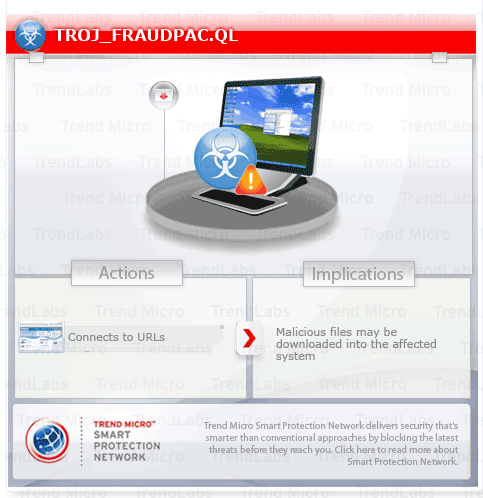TROJ_FRAUDPAC.QL
Windows 98, ME, NT, 2000, XP, Server 2003


Threat Type: Trojan
Destructiveness: No
Encrypted: No
In the wild: Yes
OVERVIEW
This Trojan has received attention from independent media sources and/or other security firms.
To get a one-glance comprehensive view of the behavior of this Trojan, refer to the Threat Diagram shown below.

This Trojan may arrive bundled with malware packages as a malware component. It may be downloaded by other malware/grayware from remote sites.
As of this writing, the said sites are inaccessible.
TECHNICAL DETAILS
Arrival Details
This Trojan may arrive bundled with malware packages as a malware component.
It may be downloaded by the following malware/grayware from remote sites:
- TROJ_PIDIEF.AAL
Installation
This Trojan drops the following copies of itself into the affected system:
- %System%\imagehlpj.exe
(Note: %System% is the Windows system folder, which is usually C:\Windows\System on Windows 98 and ME, C:\WINNT\System32 on Windows NT and 2000, or C:\Windows\System32 on Windows XP and Server 2003.)
It injects itself into the following processes running in the affected system's memory:
- SVCHOST.EXE
Autostart Technique
This Trojan registers itself as a system service to ensure its automatic execution at every system startup by adding the following registry entries:
HKEY_LOCAL_MACHINE\SYSTEM\CurrentControlSet\
Services\ShellHWDetectionVMTools
Type = "110"
Start = "2"
ErrorControl = "0"
ImagePath = "%System%\imagehlpj.exe srv"
DisplayName = "Shell Hardware Detection ShellHWDetectionVMTools"
ObjectName = "LocalSystem"
Download Routine
As of this writing, the said sites are inaccessible.
Other Details
This Trojan connects to the following possibly malicious URL:
- http://{BLOCKED}ide.net/v44/index.php
- http://{BLOCKED}.net/v44/index.php
- http://{BLOCKED}o.com/v44/index.php
SOLUTION
Step 1
For Windows XP and Windows Server 2003 users, before doing any scans, please make sure you disable System Restore to allow full scanning of your computer.
Step 2
Delete this registry key
Important: Editing the Windows Registry incorrectly can lead to irreversible system malfunction. Please do this step only if you know how or you can ask assistance from your system administrator. Else, check this Microsoft article first before modifying your computer's registry.
- In HKEY_LOCAL_MACHINE\SYSTEM\CurrentControlSet\Services
- ShellHWDetectionVMTools
- ShellHWDetectionVMTools
Step 3
Scan your computer with your Trend Micro product to delete files detected as TROJ_FRAUDPAC.QL. If the detected files have already been cleaned, deleted, or quarantined by your Trend Micro product, no further step is required. You may opt to simply delete the quarantined files. Please check this Knowledge Base page for more information.
Did this description help? Tell us how we did.


